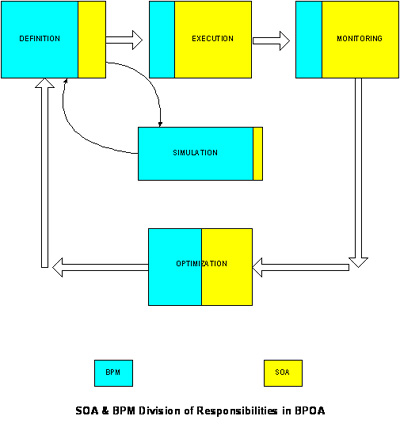In the first part of this article, I discussed the need for BPM and SOA to come together. In this part, I shall make an effort to predict the effect this tango may have on the enterprise. From the Forrester point of view, BPM can be viewed from three distinct perspectives. The first one is in relation to human-centric business processes, traditionally called human workflow management. The second one has content –centric business processes in focus. The final one that has been receiving all the attention these days is the integration-centric business process. For the integration-centric business processes involving process orchestration and system integration, the services infrastructure plays a key role in connecting the parts of a business process. As a result, the management of these integration-centric business processes has tighter alignment with SOA than the content-centric business processes. We shall focus on the integration (systems to system and human to system) perspective of BPM for the rest of this article.
One of the possible outcomes of the nexus between SOA and BPM is them losing their individual identity and coalescing into something more holistic and more pervasive across the enterprise. This nascent discipline is called the Business Process Oriented Architecture (BPOA) that borrows parts from BPM and parts from SOA. It borrows the conceptual architecture from BPM with process, rule, metrics definition mapping it to the business strategy and organizational goal. It also gets the process analysis and optimization from BPM. SOA contributes to BPOA, the runtime architecture with integration, repository and inter-operability of the orchestrated business services. SOA and BPM come together to provide the monitoring aspect of the business process. In order to complete the life cycle the BPOA runs the process analytics and process optimization to contribute to the business process improvement. The diagram below shows a typical life cycle in BPOA starting with definition, proceeding with execution and completing the loop with optimization based on results monitoring. It shows further, the role that the SOA and BPM disciplines play in each of the phases in the BPOA lifecycle.

The diagram above shows BPM playing a major role in the definition phase. This phase deals with the modeling of business processes and defining of the business rules that go along with it. In this phase the metrics related to the success factors for the business processes are defined. SOA deals with the modeling of the services from the business processes. The services model forms the platform independent abstraction of the business processes in a Model Driven Architecture. It is worth noting the services here are meant to represent the digital aspects of the business processes and are used at a broader context.
The next phase is the execution of the business processes that were defined earlier. This phase deals with the construction, deployment and implementation of business processes. In this phase, SOA takes the lead in designing the service components based on the services model and constructing those business services. Here the platform specific component models are derived from the services model. Subsequently the deployment and implementation of these business services occur. BPM plays a lean role in providing the business process / rule repositories for storage and access by business services. The BPM and SOA jointly provide the business process orchestration portion of this phase.
The final two phases deal with monitoring and optimization of the business processes and business services. The BPM and SOA work in conjunction here. The service implementations are monitored and are tied back to the gross level business processes. The results from the business services are mapped back to the performance of the business processes. The deviations of results from the target are measured and analyzed. The business process improvement leading from the optimization of the business processes and services close the loop.
In order for the transition of phases in the business process lifecycle to be seamless, adherence to a standard based approach is required. A software developer may take the business process model (defined in BPMN, for example) produced by a modeling tool like System Architect or IBM’s process modeler and feed it into Rational Software Architect to continue with the services modeling. The business services may be implemented in BEA’s Weblogic or IBM’s Websphere and monitored by webMethods Optimize. I am not recommending usage of all possible products in implementing a business process. The example above is to highlight the need for inter-operability of various products in the BPM and SOA arena and leverage the investments that are already being made in each of our organizations.
The challenges in front of the user communities and vendors alike are developing BPOA without many guidelines and standards. Although BPM and SOA standards are somewhat well established, very little has been done in terms of standards for the interplay of BPM and SOA. Services modeling, services orchestration related to BPM and business activity monitoring standards are still lacking. In the ever-changing SOA and BPM landscape vendors are scared to follow the standards that are emerging.
By viewing services as implementation of the digital model of the business processes, BPOA puts up a BPM face for business. Similarly, viewing the business services as derivatives of the business processes shall make BPOA put up a SOA face for IT. Thus BPOA facilitates bridging the chasm between business and IT. BPOA shall put an end to the criticism that SOA has too much focus on software and hardware architecture and not much on business processes. Business starts understanding SOA and IT understands the business processes with a SOA perspective. This helps IT to partner with business to facilitate building efficient processes, changing existing ones easily and to enable building newer ones.
Time will say how far my predictions on BPOA come true. I welcome feedback on this article and shall be interested to know where you think BPOA takes us.

















